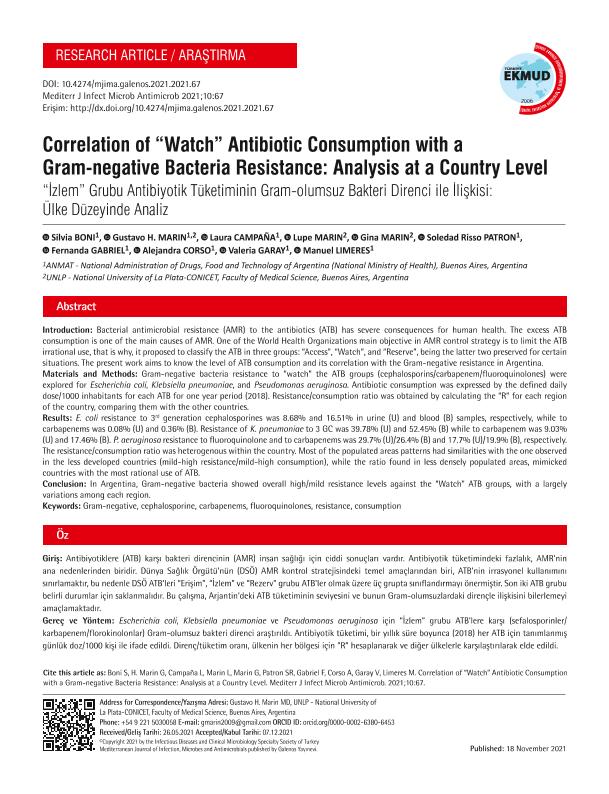Artículo
Correlation of Watch Antibiotic Consumption with a Gram-negative Bacteria Resistance: Analysis at a Country Level
Boni, Silvia; Marin, Gustavo Horacio ; Campaña, Laura; Marin, Lupe; Marin, G.; Risso Patron, Soledad; Gabriel, Fernanda; Corso, Alejandra; Garay, Valeria; Limeres, Manuel
; Campaña, Laura; Marin, Lupe; Marin, G.; Risso Patron, Soledad; Gabriel, Fernanda; Corso, Alejandra; Garay, Valeria; Limeres, Manuel
 ; Campaña, Laura; Marin, Lupe; Marin, G.; Risso Patron, Soledad; Gabriel, Fernanda; Corso, Alejandra; Garay, Valeria; Limeres, Manuel
; Campaña, Laura; Marin, Lupe; Marin, G.; Risso Patron, Soledad; Gabriel, Fernanda; Corso, Alejandra; Garay, Valeria; Limeres, Manuel
Fecha de publicación:
02/2022
Editorial:
Galenos Publishing House
Revista:
Mediterranean Journal of Infection, Microbes and Antimicrobials
e-ISSN:
2147-673X
Idioma:
Inglés
Tipo de recurso:
Artículo publicado
Clasificación temática:
Resumen
Introduction: Bacterial antimicrobial resistance (AMR) to the antibiotics (ATB) has severe consequences for human health. The excess ATB consumption is one of the main causes of AMR. One of the World Health Organizations main objective in AMR control strategy is to limit the ATB irrational use, that is why, it proposed to classify the ATB in three groups: “Access”, “Watch”, and “Reserve”, being the latter two preserved for certain situations. The present work aims to know the level of ATB consumption and its correlation with the Gram-negative resistance in Argentina. Materials and Methods: Gram-negative bacteria resistance to “watch” the ATB groups (cephalosporins/carbapenem/fluoroquinolones) were explored for Escherichia coli, Klebsiella pneumoniae, and Pseudomonas aeruginosa. Antibiotic consumption was expressed by the defined daily dose/1000 inhabitants for each ATB for one year period (2018). Resistance/consumption ratio was obtained by calculating the “R” for each region of the country, comparing them with the other countries. Results: E. coli resistance to 3rd generation cephalosporines was 8.68% and 16.51% in urine (U) and blood (B) samples, respectively, while to carbapenems was 0.08% (U) and 0.36% (B). Resistance of K. pneumoniae to 3 GC was 39.78% (U) and 52.45% (B) while to carbapenem was 9.03% (U) and 17.46% (B). P. aeruginosa resistance to fluoroquinolone and to carbapenems was 29.7% (U)/26.4% (B) and 17.7% (U)/19.9% (B), respectively. The resistance/consumption ratio was heterogenous within the country. Most of the populated areas patterns had similarities with the one observed in the less developed countries (mild-high resistance/mild-high consumption), while the ratio found in less densely populated areas, mimicked countries with the most rational use of ATB. Conclusion: In Argentina, Gram-negative bacteria showed overall high/mild resistance levels against the “Watch” ATB groups, with a largely variations among each region.
Palabras clave:
ANTIMICROBIALS
,
WATCH
,
RESISTANCE
,
ARGENTINA
Archivos asociados
Licencia
Identificadores
Colecciones
Articulos(CCT - LA PLATA)
Articulos de CTRO.CIENTIFICO TECNOL.CONICET - LA PLATA
Articulos de CTRO.CIENTIFICO TECNOL.CONICET - LA PLATA
Citación
Boni, Silvia; Marin, Gustavo Horacio; Campaña, Laura; Marin, Lupe; Marin, G.; et al.; Correlation of Watch Antibiotic Consumption with a Gram-negative Bacteria Resistance: Analysis at a Country Level; Galenos Publishing House; Mediterranean Journal of Infection, Microbes and Antimicrobials; 10; 67; 2-2022; 1-9
Compartir
Altmétricas



